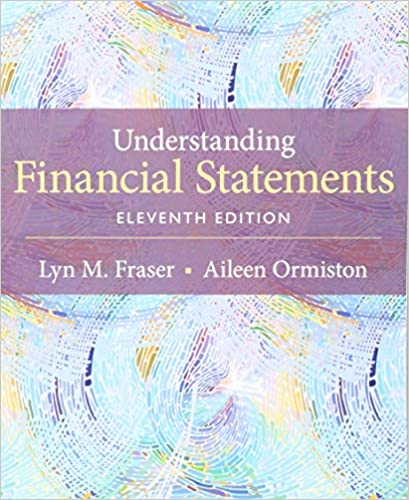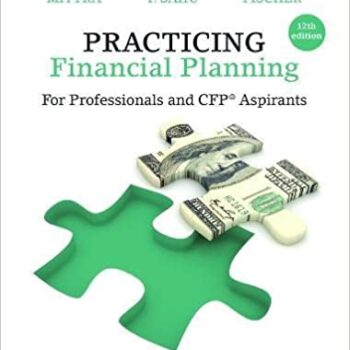Understanding Financial Statements 11th Edition By Ormiston Frasier -Test Bank
Original price was: $75.00.$25.00Current price is: $25.00.
Digital item No Waiting Time Instant Download
Publisher : Pearson; 11th edition (December 24, 2014)
Author: Lyn Fraser Aileen Ormiston
Language : English
ISBN-10 : 0133874036
ISBN-13 : 978-0133874037
Description
Understanding Financial Statements 11th Edition By Ormiston Frasier -Test Bank
Test Questions and Solutions
Chapter 1
True-False
1. A firm’s annual report contains only two pieces of information: the financial statements and the notes to the financial statements.
2. The SEC regulates U.S. companies that issue securities to the public and requires the issuance of a prospectus for any new security offering.
3. The FASB has congressional authority to set accounting policies.
4. The European Union began requiring publicly traded companies to use U.S. GAAP in 2005.
5. External auditors are required to audit the internal control assessment of the company as well as the financial statements.
6. Congress passed the Sarbanes-Oxley Act of 2002 in hopes of ending future accounting scandals and renewing investor confidence in the marketplace.
7. The Management Discussion and Analysis is of potential interest to the analyst because it contains information that cannot be found in the financial data.
8. Information that is significant enough to make a difference in a decision is considered to be immaterial.
9. The time period assumption assumes a two year time frame with interim reporting occurring daily and weekly.
10. GAAP-based financial statements are prepared according to the accrual basis of accounting.
Fill in the Blank
1. The requires all public companies to file a Form 10-K report annually.
2. A corporate annual report contains financial statements.
3. is responsible for the preparation of the financial statements, including the notes, and the attests to the fairness of the presentation.
4. The was passed in 2002 and was one of the most sweeping corporate reforms since the Securities Act of 1934.
5. The is a document used to solicit shareholder votes.
6. The Assumption is the assumed unit of measurement when preparing financial statements.
7. The cash basis of accounting recognizes when cash is received and recognizes when cash is paid.
8. The sharper and clearer the picture presented through the financial data and the closer that picture is to financial reality, the higher the financial statements and reported earnings.
9. One of the generally accepted accounting principles that provide the foundation for preparing financial statements is the principle.
10. Management exercises control over the budget level and timing of expenditures.
Multiple Choice
1. What information would not be found in a firm’s annual report?
a. Notes to the financial statements.
b. Financial Reporting Rulings.
c. Auditor’s report.
d. High and low stock prices.
2. Which agency requires the filing of Form 10-Ks, Form 10-Qs and Form 8-Ks?
a. FASB.
b. IASB.
c. SEC.
d. GAAP.
3. Which of the following statements is true?
a. Foreign firms registered with the SEC may file reports based on IFRS.
b. U.S. firms registered with the SEC may file reports based on IFRS.
c. The European Union requires firms to report based on GAAP.
d. Foreign firms registered with the SEC may file reports based on IFRS only if they reconcile all amounts to GAAP.
4. Which financial statement presents the results of operations?
a. Balance sheet.
b. Statement of financial position.
c. Income statement.
d. Statement of cash flows.
5. Which financial statement shows the assets, liabilities and stockholders’ equity of the firm on a particular date?
a. Statement of stockholders’ equity.
b. Statement of cash flows.
c. Earnings statement.
d. Balance sheet.
6. Which financial statement provides information about operating, financing and investing activities?
a. Statement of financial position.
b. Statement of cash flows.
c. Statement of stockholders’ equity.
d. Income statement.
7. What information can be found on a statement of stockholders’ equity?
a. A reconciliation of the cash account and the retained earnings account.
b. A reconciliation of the beginning and ending balances of all accounts that appears in the stockholders’ equity section of the balance sheet.
c. A reconciliation of the operating, investing and financing activities of a firm.
d. A reconciliation of net profit or loss and the cash account.
8. What basic financial statements can be found in a corporate annual report?
a. Balance sheet, income statement, statement of shareholders’ equity, and statement of cash flows.
b. Balance sheet, auditor’s report and income statement.
c. Earnings statement and statement of retained earnings.
d. Statement of cash flows and five-year summary of key financial data.
9. What is an unqualified audit report?
a. A report stating that the auditors are not qualified to report on a firm.
b. A report that states the financial statements are in violation of GAAP.
c. A report that states that departures from GAAP exist in the firm’s financial statements.
d. A report that states the financial statements are presented fairly, in all material respects, and are in conformity with GAAP.
10. What is a qualified report?
a. A report stating that the auditors are not qualified to report on a firm.
b. A report that states the financial statements are in violation of GAAP.
c. A report that states that departures from GAAP exist in the firm’s financial statements.
d. A report that states the financial statements are presented fairly, in all material respects, and are in conformity with GAAP.
11. What organization has the authority to register, inspect, and discipline auditors of all publicly owned companies?
a. Public Company Accounting Oversight Board.
b. SOX.
c. Congress.
d. FASB.
12. According to Section 302 of the Sarbanes-Oxley Act, who must certify the accuracy of the financial statements of a public company?
a. Public Company Accounting Oversight Board.
b. SEC.
c. External auditor.
d. CEO and CFO.
13. All of the following items should be discussed in the management discussion and analysis except for:
a. Anticipated changes in the mix and cost of financing resources.
b. The market value of all assets.
c. The internal and external sources of liquidity.
d. Unusual or infrequent transactions that affect income from continuing operations.
14. Which of the following is an internal source of liquidity?
a. Borrowing.
b. Sales of stock.
c. Gifts and donations.
d. Sales of products or services.
15. Which of the following is an external source of liquidity?
a. Sales of services.
b. Repurchase of stock.
c. Borrowing.
d. Sales of products.
16. Which of the following is not a condition that must be met for an item to be recorded as revenue?
a. Revenues must be earned.
b. The amount of the revenue must be measurable.
c. The revenue must be received in cash.
d. The costs of generating the revenue can be determined.
17. How are revenues and expenses recognized under the accrual basis of accounting?
a. Revenues are recognized when cash is received and expenses are recognized when cash is paid.
b. Revenues and expenses are recognized equally over a twelve month period.
c. Revenues and expenses are recognized based on the choices of management.
d. Revenues are recognized in the accounting period when the sale is made and expenses are recognized in the period in which they relate to the sale of the product.
18. In what industry would it be expected that companies would spend a significant amount on research and development activities?
a. Pharmaceutical.
b. Clothes retailer.
c. Groceries.
d. Wholesale distributor of computer parts.
19. Which of the following items is a discretionary expenditure?
a. Union wages.
b. Factory building to produce inventory.
c. Advertising.
d. Taxes.
20. Which of the following statements is false with regard to quality of financial reporting?
a. Financial statements should reflect an accurate picture of a company’s financial condition and performance.
b. It is unlikely that management can manipulate the bottom line due to the regulations in place to enforce GAAP.
c. Financial information should be useful both to assess the past and predict the future.
d. The closer that the picture presented through the financial data is to reality, the higher the quality of financial reporting.





Be the first to review “Understanding Financial Statements 11th Edition By Ormiston Frasier -Test Bank”